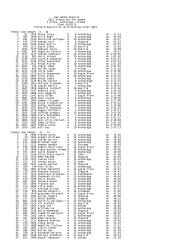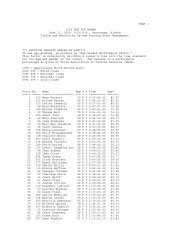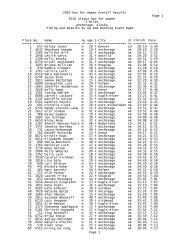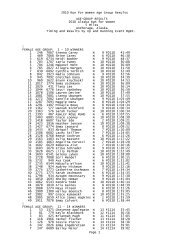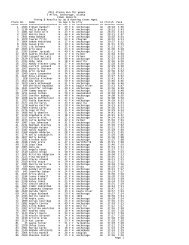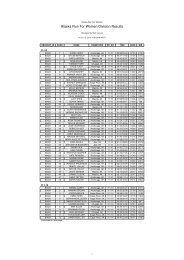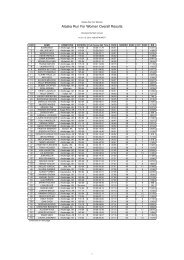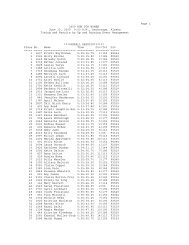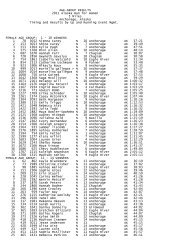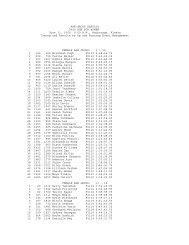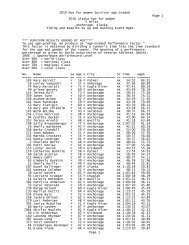The Origins of the Alaska Run for Women
The Origins of the Alaska Run for Women
The Origins of the Alaska Run for Women
You also want an ePaper? Increase the reach of your titles
YUMPU automatically turns print PDFs into web optimized ePapers that Google loves.
<strong>The</strong> <strong>Origins</strong> <strong>of</strong> <strong>the</strong> <strong>Alaska</strong> <strong>Run</strong> <strong>for</strong> <strong>Women</strong><br />
By Terri Pauls<br />
Confirmed by Dan Ellsworth and Lisa Keller<br />
June 14, 2010<br />
<strong>The</strong> idea <strong>for</strong> <strong>the</strong> <strong>Alaska</strong> <strong>Run</strong> <strong>for</strong> <strong>Women</strong> occurred on Mo<strong>the</strong>r’s Day, May 9, 1993. Anchorage residents Dan Ellsworth and<br />
I were reading <strong>the</strong> Sunday morning Anchorage Daily News over brunch when we noticed <strong>the</strong> headline <strong>of</strong> Lew<br />
Freedman’s column on <strong>the</strong> front page <strong>of</strong> <strong>the</strong> Sports section: “<strong>Run</strong>ners, get mad! <strong>Run</strong> but don’t pay; $20 is outrageous.” It<br />
outlined some changes to <strong>the</strong> 16 th annual <strong>Alaska</strong> <strong>Women</strong>’s <strong>Run</strong>, which, with 3,400 participants, had become one <strong>of</strong> <strong>the</strong><br />
largest women’s runs in <strong>the</strong> country. <strong>The</strong> entry fee was raised from $16 to $20, with no discounts <strong>for</strong> young girls or<br />
seniors. Age group prizes were eliminated. Prizes <strong>for</strong> overall top finishers were diminished. <strong>The</strong> t-shirts were changed<br />
from long-sleeve to short-sleeve. Freedman called it a “rip-<strong>of</strong>f” and encouraged women to ei<strong>the</strong>r boycott <strong>the</strong> event or to<br />
run as bandits – runners who don’t register and who <strong>the</strong>re<strong>for</strong>e, with <strong>the</strong> technology <strong>of</strong> <strong>the</strong> time, could screw up results at<br />
<strong>the</strong> finish line. <strong>The</strong> last line read, “<strong>The</strong> women who have supported <strong>the</strong> <strong>Women</strong>’s <strong>Run</strong> all <strong>the</strong>se years deserve better<br />
treatment.”<br />
I had never participated in <strong>the</strong> <strong>Alaska</strong> <strong>Women</strong>’s <strong>Run</strong>. I had moved to Anchorage only two years prior, but had an athletic<br />
background as a national-level cross-country ski racer. I’ve also been told that I have “an overdeveloped sense <strong>of</strong> justice.”<br />
Dan had been an active member <strong>of</strong> <strong>the</strong> athletic community <strong>of</strong> Anchorage <strong>for</strong> about 15 years, both as a participant and a<br />
race organizer. He was incensed by Freedman’s article. He knew <strong>the</strong> history <strong>of</strong> <strong>the</strong> <strong>Alaska</strong> <strong>Women</strong>’s <strong>Run</strong>, and told me <strong>of</strong><br />
<strong>the</strong> many ways in which women had felt frustrated and angry with <strong>the</strong> race organizers over <strong>the</strong> previous 12 years.<br />
<strong>Women</strong> wondered where <strong>the</strong>ir entry fees went, since none <strong>of</strong> it was given to charity. Race organizers reportedly<br />
responded in a disrespectful manner when women made suggestions, such donating some <strong>of</strong> <strong>the</strong> race proceeds back to<br />
<strong>the</strong> community, allowing strollers, or having kids’ t-shirts. Many women were miffed by <strong>the</strong> fact that elite runners were<br />
flown in from <strong>the</strong> lower 48 <strong>for</strong> <strong>the</strong> event, but no <strong>Alaska</strong> runners were flown out to run o<strong>the</strong>r races. <strong>The</strong> race director<br />
apparently lavished attention and parties on <strong>the</strong> out-<strong>of</strong>-state elite runners while ignoring <strong>the</strong> local stars. Also, women<br />
were not allowed to be part <strong>of</strong> <strong>the</strong> decision-making process. <strong>The</strong> list <strong>of</strong> complaints went on, and soon I agreed with Dan<br />
that something needed to be done – something more productive than boycotting or running as a bandit.<br />
“We should just put on our own race,” said Dan, who considers himself more <strong>of</strong> a feminist than some women are. “My<br />
friend Brooks Wade and I could provide an accurate course with accurate timing, but you’d have to do all <strong>the</strong> rest,<br />
because you’re <strong>the</strong> woman.” He picked up <strong>the</strong> phone and called Brooks, who zestfully agreed. His wife Rita chimed in<br />
on <strong>the</strong> idea <strong>of</strong> an alternative run, “It’s about time!”<br />
<strong>The</strong> <strong>Alaska</strong> <strong>Women</strong>’s <strong>Run</strong> was scheduled <strong>for</strong> Saturday, June 5 – less than a month away. In order to <strong>of</strong>fer a true<br />
alternative, and to accommodate <strong>the</strong> out-<strong>of</strong>-town women who had already made plans to travel to Anchorage <strong>for</strong> <strong>the</strong> June<br />
5 event, we talked about scheduling our run on <strong>the</strong> same day, at <strong>the</strong> same time.<br />
But I was not ready to organize this event without fur<strong>the</strong>r investigation. I wanted to go to <strong>the</strong> source. So I asked Dan to<br />
give me <strong>the</strong> names <strong>of</strong> <strong>Alaska</strong>’s top women runners.<br />
Over <strong>the</strong> next few days, I spoke with about a dozen <strong>of</strong> <strong>the</strong>m. Most echoed Rita Wade’s sentiments, but <strong>the</strong>y didn’t want<br />
to go ahead with a new run right away; <strong>the</strong>y wanted to meet with <strong>the</strong> race director <strong>of</strong> <strong>the</strong> <strong>Alaska</strong> <strong>Women</strong>’s <strong>Run</strong> and talk<br />
with him about how that event could benefit women.<br />
So I called <strong>the</strong> race director, who had heard rumor <strong>of</strong> an alternative run. He said that most athletic events are not<br />
fundraisers, and that he had no desire to donate any proceeds from <strong>the</strong> run because he and o<strong>the</strong>rs worked year-round on<br />
it and deserved to be paid <strong>for</strong> <strong>the</strong>ir work. I asked if he would be willing to meet with some <strong>of</strong> <strong>the</strong> top runners to address<br />
some o<strong>the</strong>r concerns, but he refused. I told him that he left me no o<strong>the</strong>r choice than to go ahead with an alternative run.<br />
Reporting this in<strong>for</strong>mation back to <strong>the</strong> top women runners, enthusiasm <strong>for</strong> an alternative run blossomed. Although a<br />
couple <strong>of</strong> <strong>the</strong>m did not want to get involved in a controversy, most embraced <strong>the</strong> opportunity to create something better.<br />
Judy (Gower) Meisner, Lisa Keller, Gerri Litzenberger, Ruth (Horton) Barndt, Tamaris Dortch, Kathleen Dunbar, and<br />
Nancy Pease agreed to have <strong>the</strong>ir names listed as supporters in newspaper ads announcing <strong>the</strong> event. With that level <strong>of</strong><br />
allegiance from <strong>Alaska</strong>’s top women runners, I committed to organizing <strong>the</strong> event. We now had only three weeks to go<br />
until race day.
But what should I call this event? I thought about “<strong>Alaska</strong> <strong>Run</strong> <strong>for</strong> <strong>Women</strong>,” but feared legal retaliation if I used a name<br />
too similar to <strong>the</strong> <strong>Alaska</strong> <strong>Women</strong>’s <strong>Run</strong>. So I named <strong>the</strong> 1993 event <strong>the</strong> Anchorage <strong>Run</strong> <strong>for</strong> <strong>Women</strong>.<br />
At about that time, I read a letter to <strong>the</strong> editor written by surgeon Roland Gower. He suggested that if <strong>the</strong> <strong>Alaska</strong><br />
<strong>Women</strong>’s <strong>Run</strong> was going to increase <strong>the</strong>ir entry fee and cut back on perks, <strong>the</strong>y might consider donating some proceeds to<br />
fighting breast cancer. That sounded good to me. In fact, Dan and I decided to charge no fee at all <strong>for</strong> our alternative run,<br />
asking only <strong>for</strong> voluntary donations <strong>of</strong> any amount to fight breast cancer.<br />
I wanted <strong>the</strong> Anchorage <strong>Run</strong> <strong>for</strong> <strong>Women</strong> to benefit all women, not just those who had already contracted breast cancer.<br />
So I asked <strong>the</strong> American Cancer Society and <strong>the</strong> National Cancer Institute if I could earmark <strong>the</strong> money we raised <strong>for</strong><br />
breast cancer research, in order to prevent it in <strong>the</strong> first place. That was not possible through <strong>the</strong>ir organizations, but <strong>the</strong>y<br />
referred me to <strong>the</strong> Susan G. Komen Foundation, which assured me that our proceeds could be earmarked <strong>for</strong> scientific<br />
research on how to prevent or cure breast cancer.<br />
For a logo, I drew a simple, 5-line “swish” design <strong>of</strong> a woman running. Graphic artist Lori Rodgers made it t-shirt ready<br />
as a sponsorship donation. That first year, it served as both logo <strong>for</strong> ads and brochures, and design <strong>for</strong> <strong>the</strong> hot pink tank<br />
tops. It remained <strong>the</strong> business logo <strong>of</strong> <strong>the</strong> organization <strong>for</strong> many years.<br />
In looking <strong>for</strong> sponsors, I first approached women-owned businesses. Craciun & Associates, attorney Allison Mendel,<br />
<strong>The</strong> Bagel Factory, and <strong>the</strong> <strong>Alaska</strong> <strong>Women</strong>’s Bookstore provided immediate support.<br />
My newspaper ads included my name, phone number, and a request <strong>for</strong> assistance. Calls poured in. Most<br />
enthusiastically <strong>of</strong>fered help and support, but a few voiced opposition. Understandably, some women felt loyal to <strong>the</strong><br />
<strong>Alaska</strong> <strong>Women</strong>’s <strong>Run</strong>. It was <strong>the</strong> only athletic event that some women had ever done. For some girls, it launched athletic<br />
careers. And some women felt that its spirit <strong>of</strong> sisterhood was still alive and well. <strong>The</strong>se people urged me not to destroy<br />
<strong>the</strong> 16 year-old institution.<br />
Now, I did not set out to destroy anything. I organized <strong>the</strong> first <strong>Run</strong> <strong>for</strong> <strong>Women</strong> because it felt like <strong>the</strong> right thing to do. I<br />
saw it as a better, more positive alternative than boycotting <strong>the</strong> <strong>Alaska</strong> <strong>Women</strong>’s <strong>Run</strong> or running it as a bandit. I was<br />
focused on our event, not on <strong>the</strong> <strong>Women</strong>’s <strong>Run</strong> or what might happen after June 5. Maybe we would just make a<br />
statement this one year, and effect some positive change in <strong>the</strong> <strong>Women</strong>’s <strong>Run</strong>.<br />
But because we had scheduled <strong>the</strong> <strong>Run</strong> <strong>for</strong> <strong>Women</strong> <strong>for</strong> <strong>the</strong> same time as <strong>the</strong> <strong>Women</strong>’s <strong>Run</strong>, <strong>the</strong> media picked it up as a<br />
conflict. Television cameras pointed fixedly at me as reporters inquired, “Why are you dividing <strong>the</strong> athletic community<br />
<strong>of</strong> Anchorage by protesting <strong>the</strong> <strong>Alaska</strong> <strong>Women</strong>’s <strong>Run</strong>?” I never described it as a protest. I responded that we were<br />
simply <strong>of</strong>fering an alternative <strong>for</strong> women who ei<strong>the</strong>r couldn’t af<strong>for</strong>d or refused to pay <strong>the</strong> <strong>Alaska</strong> <strong>Women</strong>’s <strong>Run</strong> $20 entry<br />
fee, or wanted <strong>the</strong>ir money to go to a good cause. I explained some <strong>of</strong> <strong>the</strong> reasons that <strong>the</strong> community seemed to be at a<br />
boiling point <strong>of</strong> frustration regarding <strong>the</strong> <strong>Women</strong>’s <strong>Run</strong>.<br />
None<strong>the</strong>less, I felt <strong>the</strong> heat. I heard that <strong>the</strong> “dueling races,” as portrayed by <strong>the</strong> media, had become <strong>the</strong> talk <strong>of</strong> <strong>the</strong> town.<br />
Our group <strong>of</strong> top women runners had been strongly encouraging women – both in person and in <strong>the</strong> media -- to<br />
participate in <strong>the</strong> <strong>Run</strong> <strong>for</strong> <strong>Women</strong>. “Which race are you running?” apparently triggered some spirited debates. It seemed<br />
that half <strong>of</strong> <strong>the</strong> athletic community <strong>of</strong> Anchorage loved me, while <strong>the</strong> o<strong>the</strong>r half hated me. As a 28 year-old with a thin<br />
skin, <strong>the</strong>re were mornings when I woke up and wished that <strong>the</strong> whole thing had been just a bad dream.<br />
My three weeks <strong>of</strong> race organizing would not have been possible if I had had a normal job at <strong>the</strong> time. I worked on <strong>the</strong><br />
run almost every waking hour, taking a one-hour break every day to go <strong>for</strong> my own run. From obtaining race permits to<br />
renting Porta-Potties, from marketing <strong>the</strong> event to organizing volunteers, I was starting from scratch and was totally<br />
immersed.<br />
People came out <strong>of</strong> <strong>the</strong> woodwork to <strong>of</strong>fer help with <strong>the</strong> race. <strong>The</strong> Anchorage <strong>Run</strong>ning Club and <strong>the</strong> Nordic Ski<br />
Association <strong>of</strong> Anchorage <strong>of</strong>fered to loan <strong>the</strong>ir race equipment free <strong>of</strong> charge. Members <strong>of</strong> <strong>the</strong> Arctic Orienteering Club<br />
<strong>of</strong>fered to help Dan and Brooks set up <strong>the</strong> start / finish area at Westchester Lagoon and assist with timing. Greg Cress<br />
<strong>of</strong>fered to serve as Chief <strong>of</strong> Course, which was a 10-kilometer, out-and-back route on <strong>the</strong> Coastal Trail toward Earthquake<br />
Park. Roy Sersa coordinated a group <strong>of</strong> EMTs to staff aid stations. Ginny Moore served as registrar, Jeni Winegarner<br />
organized food and water stations, and Ruth Horton obtained prizes. Karen Jettmar <strong>of</strong>fered to announce. Many o<strong>the</strong>rs
helped, too. Never be<strong>for</strong>e or since has <strong>the</strong> delegation <strong>of</strong> tasks been such a breeze <strong>for</strong> me – everyone was so talented at<br />
what <strong>the</strong>y did, and followed through seamlessly.<br />
Judy (Gower) Meisner helped with obtaining insurance, which was a challenge. Most races got it through USA Track &<br />
Field, but <strong>the</strong> USATF representative <strong>for</strong> Anchorage was also <strong>the</strong> registrar <strong>for</strong> <strong>the</strong> <strong>Alaska</strong> <strong>Women</strong>’s <strong>Run</strong>, and she refused to<br />
work with us. So Judy found insurance independently.<br />
Lupe Marroquin helped distribute brochures. <strong>The</strong> two <strong>of</strong> us were putting <strong>the</strong>m on <strong>the</strong> cars parked at <strong>the</strong> <strong>Women</strong>’s Gold<br />
Nugget Triathlon when we discovered that <strong>the</strong> wife <strong>of</strong> <strong>the</strong> race director <strong>of</strong> <strong>the</strong> <strong>Alaska</strong> <strong>Women</strong>’s <strong>Run</strong> was removing <strong>the</strong>m<br />
and throwing <strong>the</strong>m on <strong>the</strong> ground. We joked about reporting her <strong>for</strong> littering.<br />
Sue Fison came up with <strong>the</strong> idea <strong>of</strong> participants wearing signs pinned to <strong>the</strong> back <strong>of</strong> <strong>the</strong>ir shirts, on which <strong>the</strong>y could<br />
write <strong>the</strong> names <strong>of</strong> women <strong>the</strong>y knew who had died <strong>of</strong> breast cancer. She <strong>of</strong>fered to bring all <strong>of</strong> <strong>the</strong> materials and<br />
organize that piece.<br />
Throughout this entire process, we had no idea if we would succeed. <strong>The</strong>re wasn’t time to think about that, anyway. We<br />
just kept working.<br />
Our list <strong>of</strong> sponsors grew as <strong>the</strong> days passed. Dr. Roland Gower persuaded <strong>Alaska</strong> Regional Hospital to become our<br />
major sponsor by donating $2000. O<strong>the</strong>r sponsors included Pen Air, <strong>Alaska</strong> Athletic Club, Heritage Real Estate, Omega<br />
Music Center, Pastels Exceptional Hair Design, Hea<strong>the</strong>r Flynn, Anne Nevaldine, Sue Walker, Four Seasons Restaurant,<br />
<strong>The</strong> Healing Center, Sylvia Condy, Craciun & Associates, Glen Arts Enterprises, Sue Jarvis (yoga), <strong>Alaska</strong> Serigraphics,<br />
<strong>Women</strong> <strong>of</strong> <strong>the</strong> Wilderness, and Cultural Resource Consultants. Communication Concepts pledged to donate $5 per<br />
minute per runner who finished under 40 minutes.<br />
Nine days be<strong>for</strong>e <strong>the</strong> race, 68 women had entered <strong>the</strong> <strong>Run</strong> <strong>for</strong> <strong>Women</strong>.<br />
On Friday, June 4 – <strong>the</strong> day be<strong>for</strong>e <strong>the</strong> race -- <strong>the</strong> headline <strong>of</strong> <strong>the</strong> front page <strong>of</strong> <strong>the</strong> Anchorage Daily News read, “<strong>Alaska</strong><br />
<strong>Women</strong>’s <strong>Run</strong> hits financial wall.” Reporter Natalie Phillips included a pie chart <strong>of</strong> <strong>the</strong> race’s 1992 expenses: $24,000 <strong>for</strong><br />
<strong>the</strong> race director’s salary; $22,000 <strong>for</strong> “o<strong>the</strong>r salaries, consultant fees;” $20,900 <strong>for</strong> “apparel” (race <strong>of</strong>ficials received fancy<br />
athletic outfits); $18,700 <strong>for</strong> “storage rental, equipment,” $11,700 <strong>for</strong> “<strong>of</strong>fice expenses,” and $5700 <strong>for</strong> “food, travel.” Many<br />
people were amazed by this plush budget.<br />
<strong>The</strong> total cash budget <strong>for</strong> <strong>the</strong> 1993 Anchorage <strong>Run</strong> <strong>for</strong> <strong>Women</strong> was $2,610, not including in-kind donations. All work put<br />
into <strong>the</strong> run was unpaid.<br />
Saturday, June 5 dawned perfectly clear. <strong>The</strong> headline on <strong>the</strong> front page <strong>of</strong> <strong>the</strong> Anchorage Daily News Sports section<br />
read, “War <strong>of</strong> <strong>the</strong> races: two women’s runs duke it out today.”<br />
We went into race day with 223 registrations. To our surprise, more than 500 additional women showed up that morning.<br />
Our start /finish area was within walking distance <strong>of</strong> <strong>the</strong> start <strong>of</strong> <strong>the</strong> <strong>Alaska</strong> <strong>Women</strong>’s <strong>Run</strong>, up <strong>the</strong> hill at West High.<br />
Numerous entrants <strong>of</strong> <strong>the</strong> <strong>Women</strong>’s <strong>Run</strong> changed <strong>the</strong>ir minds at <strong>the</strong> last minute and ran down <strong>the</strong> bike path to do <strong>the</strong><br />
<strong>Run</strong> <strong>for</strong> <strong>Women</strong> instead. Some wore <strong>the</strong>ir <strong>Women</strong>’s <strong>Run</strong> t-shirts inside-out. We had to delay <strong>the</strong> start by 15 minutes to<br />
allow time <strong>for</strong> everyone to register.<br />
At last, 758 women and girls lined up on <strong>the</strong> starting line. <strong>The</strong> gun went <strong>of</strong>f, and <strong>the</strong> race was on. I nearly collapsed with<br />
relief.<br />
36 minutes and 52 seconds later, newcomer Laura Downey crossed <strong>the</strong> finish line. Kathleen Dunbar placed second in<br />
38:31, and Wendy (Reeves) Spencer was third in 38:43. Spencer, a <strong>for</strong>mer cross-country ski national champion who<br />
usually avoided running on pavement due to previous knee and ankle injuries, said that “this was worth coming out <strong>for</strong>”<br />
because she had an aunt with breast cancer.<br />
<strong>Run</strong>ners reported that after <strong>the</strong> 5 km turn-around point, <strong>the</strong>y were cheered by <strong>the</strong> rest <strong>of</strong> <strong>the</strong> field on <strong>the</strong>ir way back to<br />
Westchester Lagoon.
As more and more women crossed <strong>the</strong> finish line, <strong>the</strong> atmosphere became electric. Joy <strong>for</strong> <strong>the</strong> event combined with grief<br />
<strong>of</strong> loss from breast cancer, and mixed with that magical sisterhood thing to put a buzz in <strong>the</strong> air. All tension over<br />
competing races disappeared as <strong>the</strong> ga<strong>the</strong>ring turned into a festive celebration.<br />
Top runner Gerri Litzenberger later wrote to me, “Belief gives birth to reality! Thank you <strong>for</strong> believing! That was one <strong>of</strong><br />
<strong>the</strong> greatest events <strong>of</strong> my life… right up <strong>the</strong>re with childbirth! I cried most <strong>of</strong> <strong>the</strong> way!”<br />
Participant donations averaged just under $20 per person – coincidentally, <strong>the</strong> same as <strong>the</strong> entry fee <strong>for</strong> <strong>the</strong> <strong>Women</strong>’s <strong>Run</strong>.<br />
Collectively, we raised $12,000 to send to <strong>the</strong> Susan G. Komen Foundation to fight breast cancer.<br />
A picnic table served as our awards stand. We awarded <strong>the</strong> overall race winner and master’s division winner free trips to<br />
<strong>the</strong> Race <strong>for</strong> <strong>the</strong> Cure – a fundraising run organized by <strong>the</strong> Susan G. Komen Foundation – in Dallas. We did not have a<br />
division <strong>for</strong> breast cancer survivors in 1993, but got <strong>the</strong> idea from <strong>the</strong> Dallas race.<br />
After all <strong>of</strong> <strong>the</strong> o<strong>the</strong>r prizes were given out, Judy called me up on top <strong>of</strong> <strong>the</strong> table. She thanked me <strong>for</strong> my work in<br />
organizing <strong>the</strong> event, and gave me a bouquet <strong>of</strong> roses, a card signed by many <strong>of</strong> <strong>the</strong> top women runners, and a race tank<br />
top that had a quote on <strong>the</strong> back from <strong>the</strong> race director <strong>of</strong> <strong>the</strong> <strong>Women</strong>’s <strong>Run</strong>: “Who <strong>the</strong> hell is Terri Pauls, anyway?!” <strong>The</strong><br />
audience gave me a standing ovation as tears rolled down my cheeks. I had stood on top <strong>of</strong> award podiums be<strong>for</strong>e as a<br />
ski racer, but I learned at that precious moment that <strong>the</strong> sense <strong>of</strong> reward derived from individual accomplishment pales in<br />
comparison to <strong>the</strong> fulfillment derived from doing something <strong>for</strong> an entire community, and being appreciated <strong>for</strong> it. <strong>The</strong>se<br />
women were grateful to me <strong>for</strong> helping <strong>the</strong>m get <strong>the</strong>ir run back. It was one <strong>of</strong> <strong>the</strong> best moments <strong>of</strong> my life.<br />
After a couple <strong>of</strong> weeks <strong>of</strong> rest, Dan, Roland, Judy, and I decided to <strong>for</strong>m a non-pr<strong>of</strong>it organization. <strong>The</strong> first meeting <strong>of</strong><br />
<strong>the</strong> Anchorage <strong>Run</strong> <strong>for</strong> <strong>Women</strong> Board <strong>of</strong> Directors took place on July 26, 1993. Members present were Dan Ellsworth,<br />
Judy (Gower) Meisner, Roland Gower, Beth Balen, Susan Fison, Jill Gates, Lisa Keller, Charlotte (Krouskop) Tharp, Louise<br />
Lazur, Sister Marilee Murphy, Nora Waters, and myself. We agreed to approach <strong>the</strong> <strong>Alaska</strong> <strong>Women</strong>’s <strong>Run</strong> about<br />
combining <strong>the</strong> two events, so that Anchorage could have one women’s run that everyone could support. We set goals <strong>for</strong><br />
<strong>the</strong> 1994 event <strong>for</strong> 2000 participants, raising $50,000 <strong>for</strong> a beneficiary. <strong>The</strong>re was some discussion around supporting<br />
causes o<strong>the</strong>r than breast cancer.<br />
<strong>The</strong> Board <strong>of</strong> Directors <strong>of</strong> <strong>the</strong> <strong>Alaska</strong> <strong>Women</strong>’s <strong>Run</strong> dissolved <strong>the</strong>ir organization as <strong>of</strong> August 4, 1993. Participation in<br />
<strong>the</strong>ir event had fallen from a record 3,448 runners in 1992 to 1,360 finishers in 1993. <strong>The</strong> discussion about joining <strong>for</strong>ces<br />
never happened.<br />
Shortly <strong>the</strong>reafter, we changed <strong>the</strong> name <strong>of</strong> our event to <strong>the</strong> <strong>Alaska</strong> <strong>Run</strong> <strong>for</strong> <strong>Women</strong>.<br />
<strong>The</strong> Susan Komen Foundation asked if <strong>the</strong> <strong>Run</strong> <strong>for</strong> <strong>Women</strong> would like to become one <strong>of</strong> <strong>the</strong>ir “Races <strong>for</strong> <strong>the</strong> Cure,” but<br />
doing so would have required us to run every decision through <strong>the</strong>m. Holding to <strong>the</strong> tradition <strong>of</strong> <strong>Alaska</strong>n independence,<br />
we declined.<br />
I did not participate in planning <strong>the</strong> 1994 race because months earlier, I had committed to participating in a study abroad<br />
program from September through May. When I returned, I felt honored to be asked to fire <strong>the</strong> starting gun <strong>for</strong> <strong>the</strong> 2 nd<br />
Annual <strong>Alaska</strong> <strong>Run</strong> <strong>for</strong> <strong>Women</strong> on June 11, 1994.<br />
I served on <strong>the</strong> board <strong>for</strong> a year or two be<strong>for</strong>e going Outside to graduate school. Over <strong>the</strong> years, my personal wish has<br />
been that <strong>the</strong> <strong>Run</strong> fund specific research into <strong>the</strong> links between syn<strong>the</strong>tic chemicals and breast cancer, with <strong>the</strong> goal <strong>of</strong><br />
decreasing <strong>the</strong> incidence <strong>of</strong> all <strong>for</strong>ms <strong>of</strong> cancer. <strong>The</strong> one time I participated in <strong>the</strong> run, joined by my mom, <strong>the</strong> sign on <strong>the</strong><br />
back <strong>of</strong> my shirt memorialized Rachel Carson.<br />
Years later, my mo<strong>the</strong>r was diagnosed with breast cancer. And later, stomach cancer. Fortunately, both were caught<br />
early and she became a survivor.<br />
1994 Historical Tidbits<br />
Roland Gower served as Chairman <strong>of</strong> <strong>the</strong> Board from 1994 - 1998.<br />
Almost 2000 participants
<strong>The</strong> 1994 route started and finished at <strong>the</strong> Sullivan Arena, and wound through <strong>the</strong> streets <strong>of</strong> Anchorage and <strong>the</strong> Coastal<br />
Trail. 5-mile and 1-mile events were <strong>of</strong>fered.<br />
$66,656 was raised to fight breast cancer, 1/3 <strong>of</strong> which was donated to <strong>the</strong> Susan Komen Foundation.<br />
Sometime after <strong>the</strong> 1993 race, <strong>the</strong> signs that women wore on <strong>the</strong>ir backs began to include <strong>the</strong> names <strong>of</strong> breast cancer<br />
survivors, as well as those who had died <strong>of</strong> <strong>the</strong> disease.<br />
1995 Historical Tidbits<br />
Nearly 3000 runners & walkers participated, including nearly 100 breast cancer survivors.<br />
Average participant donation: $16<br />
Event netted $75,000 in cash and $20,000 in donations. 70% <strong>of</strong> money raised went to <strong>Alaska</strong>n organizations <strong>for</strong> education,<br />
early detection, and programs serving breast cancer survivors, while 30% went to research. Also, mammography services<br />
were made available to low-income women.



